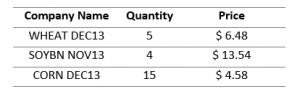What did I bought
Really inspired by the suggestion that “make as many mistakes as you can:, I just closed my eyes and jumped into the future market.
The first trade was made on Sept. 18. After watching some guide videos on Youtube and with help from classmates and Google, I bought corn, wheat and soy beans just based upon personal interest.
Unfortunately, it seems that my choices are not so good, with the portfolio return at -13.96%. Surprisingly, the portfolio return of major class turned out to be negative when I opened computer this morning, but still, mine is the lowest (sorry about my poor trading skills), it makes me so curious about what happened in the market.
Here I’d like to keep track of my adventure in Stocktark
My first trade
Top 3 mistakes I made this trading week.
- With no ideas about the future market
- Don’t understand why and how commodity prices move higher or lower
- Did not figure out what percentage of money should spend on futures
In a word, I started buying and selling with no specific market strategy. But now I am getting to know the market.
Unlike stocks or other futures, the agricultural commodity futures are more sensitive to the harvest season and demand-supply situations. Take corn as an example, corn crops around the world have their own unique production cycles of planting and harvest time-frames. Generally speaking, corn is planted in the spring and harvested in the fall. While the supply expectations often shift significantly due to weather and growing conditions in growing season, the winter months usually deal with demand and supply of the harvested crop. So it turns out that the summer months is when most of the action in corn prices take place, however, corn futures can be fairly subdued during the winter months.
So I realized that awareness of seasonal trade would be helpful when buy or sell agricultural commodities. Since the northern hemisphere is waiting for the beautiful winter, we may need to pay more attention to the demand and supply situations of the whole market.
Here, I’d like to share some resource we can access to the demand and supply situations in US.
- Prospective plantings – the main report at the beginning of the crop growing season from USDA. It is released around the end of March since 1964 and summarizes how much and which crops the farmers expect to plant for the upcoming season.
- Monthly Crop Production – Released around the 10th of each month. The report gives an update estimate of supply and demand for crop.
- Grain Stocks – Provides information on the current supply of corn and other grains in the US and the world.
The big news in agricultural futures this month
Interestingly, the price curves of corn, soybean and wheat all experienced a huge but different change on last Friday.
The changes are instant responses to the big news released on Spet. 12 – the USDA raised its outlook for the domestic harvest and projected US farmers to harvest 13.843 billion of corn this year, which exceeds the forecast made in August and would be the highest number ever. Also private analytic firm Informa Economics raised its forecast of US 2013 corn and soybean production, estimated the 2013 corn crop at 13.889 billion bushels, which above the USDA’s forest for 13.843 billion bushels.
The new domestic harvest data from USDA implies that there would be a good corn production this year and plenty of corn are available. As a result, corn futures for December delivery drop 1.7 percent to around $4.514 a bushel in CBOT, heading for a third straight weekly drop. The falling wedge may not necessarily be an ending pattern. Therefore, it seems it is not a good time to buy too many units of corn future.
Likely, the soybean dropped most in week but the trend is more likely because of the weather. It is reported that field from North Dakota to Ohio (key growing area) got as much as 2.5 cm of rain last week. Rainfall may aid some immature crops filling pods with beans. The USDA said on Sept. 12 that the global production of oil seeds including soybeans, canola and sunflower seeds will rise 4.8% this year. Abundant supply makes the soybean future for delivery in November fell 1.5% to close at $13.2 a bushel on CBOT after touching the lowest point around $13.12 since Aug.29.
Take a little break
After the first trade, all I wanna say is that it’s so wise to trade with fake money.
The price of future is changing all the time and there are so many factors, such as policy, harvest season, storage, imports and exports, demand and supply etc., can lead to big increase or decrease of the price. I think it would definitely take me some time to understand why commodity prices move up and down.
For next step, I will keep an eye on my soybean futures since it is the chief culprit of the lost and then to have a better understanding about how to choose short position and long position. Still many things to learn and more practice is necessary.
Mia



